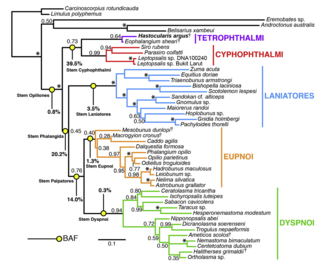
The Opiliones are an order of arachnids colloquially known as harvestmen, harvesters, harvest spiders, or daddy longlegs. As of April 2017, over 6,650 species of harvestmen have been discovered worldwide, although the total number of extant species may exceed 10,000. The order Opiliones includes five suborders: Cyphophthalmi, Eupnoi, Dyspnoi, Laniatores, and Tetrophthalmi, which were named in 2014.

Drypetes is a plant genus of the family Putranjivaceae, in the order Malpighiales.
Pacullidae is a family of araneomorph spiders first described by Eugène Simon in 1894. It was merged into Tetrablemmidae in 1958, then raised back to family status after a large phylogenetic study in 2017.

Dyspnoi is a suborder of harvestmen, currently comprising 43 extant genera and 356 extant species, although more species are expected to be described in the future. The eight families are currently grouped into three superfamilies: the Acropsopilionoidea, Ischyropsalidioidea, and Troguloidea.

Cyphophthalmi is a suborder of harvestmen, colloquially known as mite harvestmen. Cyphophthalmi comprises 36 genera, and more than two hundred described species. The six families are currently grouped into three infraorders: the Boreophthalmi, Scopulophthalmi, and Sternophthalmi.

The Phalangodidae are a family of harvestmen with about 30 genera and more than 100 described species, distributed in the Holarctic region.

The Sironidae are a family of harvestmen with more than 30 described species.

Ischyropsalididae is a family of harvestmen with 35 described species in 3 genera, found in Europe and North America.

Epedanidae is a family of the harvestman infraorder Grassatores with about 200 described species. They are the sister group of the Gonyleptoidea.
Sandokanidae is a family of harvestmen in the suborder Laniatores, formerly referred to as Oncopodidae

Samoidae is a family of the harvestman infraorder Grassatores with about fifty described species.

Harvestmen (Opiliones) are an order of arachnids often confused with spiders, though the two orders are not closely related. Research on harvestman phylogeny is in a state of flux. While some families are clearly monophyletic, that is share a common ancestor, others are not, and the relationships between families are often not well understood.
Acromitostoma is a genus of harvestmen in the family Nemastomatidae with 2 described species. Both species are from Spain, and one also originally reported from Morocco.
Bowie is a genus of Ctenidae that was described by Peter Jäger in 2022. The genus was named after the English singer-songwriter and actor David Bowie and currently encompasses 107 species, 55 of which were named after elements from David Bowie's musical catalogue.
Acropsopilionoidea is a superfamily of harvestmen with 1 family and 3 genera, found in North America and the Southern Hemisphere.
Asiolasma is a genus of harvestmen in the family Nemastomatidae with six described species . The species are found in Southeast Asia, namely China, Vietnam and Thailand. Some species are treated under other genera in Schönhofer (2013).
This page is based on this
Wikipedia article Text is available under the
CC BY-SA 4.0 license; additional terms may apply.
Images, videos and audio are available under their respective licenses.








